Why This Mission
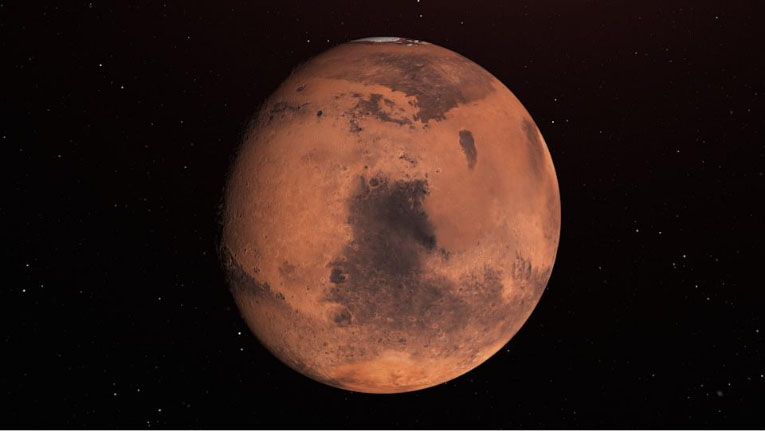 Image credit: NASA/JPL-Caltech | Full image and caption
Image credit: NASA/JPL-Caltech | Full image and caption
Billions of years ago, Earth and Mars were much more similar than they are today. Both had liquid water at the surface; both had magnetic fields to protect their surface from the Sun’s radiation. If life developed on Earth at that time, could it have also developed on Mars?
NASA has sent rovers, landers and orbiters to investigate that key astrobiological question at the Red Planet. Scientists can study rocks and sediment on the Martian landscape to learn when liquid water disappeared, and when the atmosphere started to thin. This record can reveal when Mars had the ideal conditions for life.
But Perseverance will be different: It’s the first Mars rover designed to collect samples that could one day be returned to Earth. Despite all of the rover’s immense technical capabilities, there are far more powerful laboratories and science tools on our planet than we could hope to send to Mars. As with the Moon samples returned by the Apollo missions, Mars samples can benefit future generations of scientists who will use technology that hasn’t been invented yet.
The Mars 2020 mission will also look ahead to the day when astronauts travel to Mars. Perseverance carries a new experiment called MOXIE that will test technology to convert carbon dioxide in the Martian atmosphere into oxygen that could be used for rocket propellant or breathing. The rover will also test new automated technologies that will be useful for landing humans or equipment on Mars. These efforts will feed into NASA’s plans for sending humans to Mars, with the Artemis program returning astronauts to the Moon as the first step.
Science Goals
Perseverance will contribute to the overarching goals of NASA’s Mars Exploration Program:
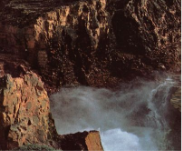
Determine whether life ever existed

Characterize the climate
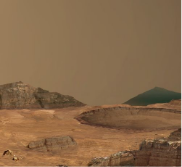
Characterize the geology
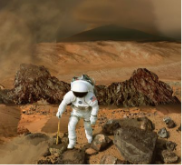
Prepare for human exploration
To reach the first three of these goals, NASA has determined the following more specific science objectives for Perseverance:
- Understand the geology of the field site explored by the Perseverance rover.
- Determine whether Perseverance’s landing site, Jezero Crater, could have supported microbial life in the distant past, and search for evidence that such ancient life may have left behind.
- Select and collect samples representing the geologic diversity of the Perseverance field site, focusing on materials with the highest potential to preserve signs of life and planetary evolution. Keep these samples pristine, isolating them from Earth-sourced contaminants.
NASA has also tasked the Mars 2020 team with a mission objective to prepare for future human exploration by conducting the following investigations:
- Demonstrate a technology that converts carbon dioxide in the Martian atmosphere into oxygen. In the future, oxygen generated this way could be used by astronauts as rocket propellant and for breathing (more on MOXIE below).
- Study how atmospheric dust could affect future technology, including human life support systems.
- Study how Mars weather could affect human explorers (more on MEDA below).
- Use sensors in the rover’s descent stage and back shell to better understand entry into the Martian atmosphere. This can help spacecraft engineers design safe landings for future astronauts traveling to Mars (more information on MEDLI2 is here).
Payload Instruments
Science instruments are state-of-the-art tools for acquiring information about Martian geology, atmosphere, environmental conditions and potential signs of life (biosignatures). The mission’s science supports the field of astrobiology, which aims to understand the origin, evolution and distribution of life in the universe.
Perseverance has seven primary science instruments.
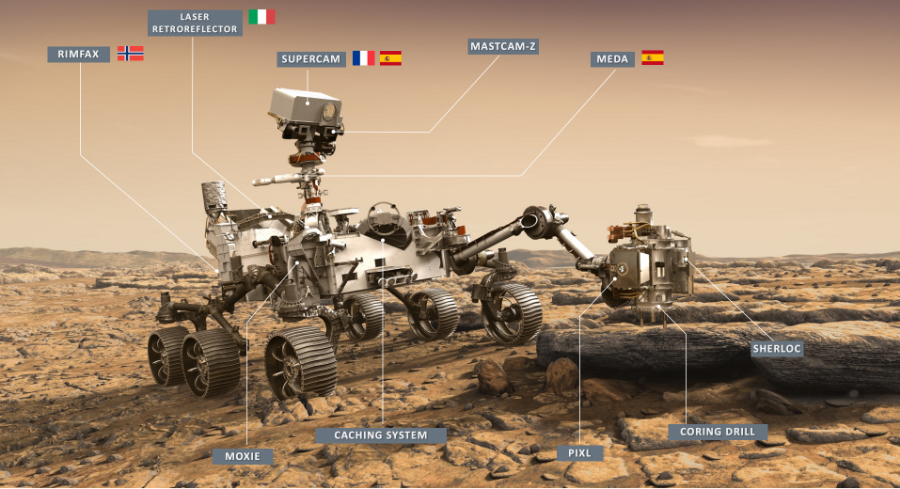 Several instruments on Perseverance involve international partners. Image credit: NASAS/JPL-Caltech | + View Larger Image
Several instruments on Perseverance involve international partners. Image credit: NASAS/JPL-Caltech | + View Larger Image
Mastcam-Z
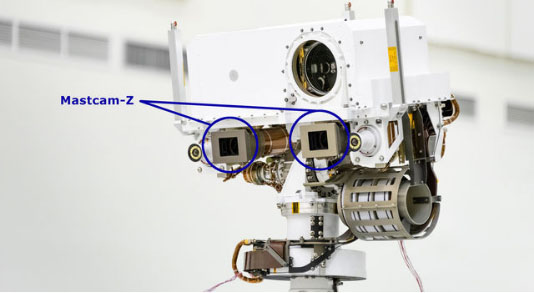 Image credit: NASA/JPL-Caltech | Full image and caption
Image credit: NASA/JPL-Caltech | Full image and caption
Principal Investigator:
Jim Bell, Arizona State University
Mastcam-Z is a pair of next-generation science cameras that sit on Perseverance’s Remote Sensing Mast, or “head.” This pair of zoomable cameras can be used to shoot video and to create high-resolution, color stereo/3D panoramas of the Martian landscape. These images help rover operators drive and place the rover’s arm instruments. Analysis of the geology and colors of the landscape help scientists determine the composition and past history of the landing site region.
Mastcam-Z
- Serves as Perseverance’s primary scientific “eyes.”
- At maximum zoom, can see a feature as small as a house fly from as far away as the length of a soccer field.
- Can build 360-degree color and stereo panoramas for rover driving and science.
MEDA (Mars Environmental Dynamics Analyzer)
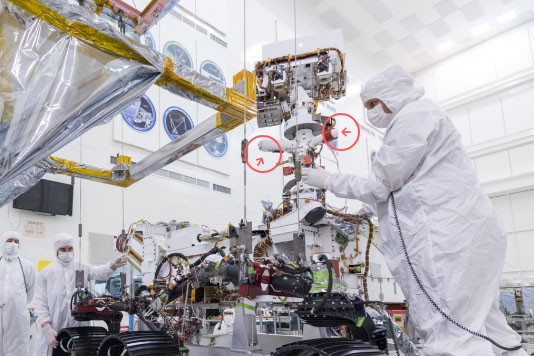 MEDA wind sensors on Perseverance’s mast. Image credit: NASA/JPL-Caltech | Full image and caption
MEDA wind sensors on Perseverance’s mast. Image credit: NASA/JPL-Caltech | Full image and caption
Principal Investigator:
Jose Rodriguez Manfredi, Centro de Astrobiología, Madrid, Spain
MEDA is a set of sensors distributed across Perseverance’s mast and body that measures wind speed and direction, air pressure, relative humidity, ambient temperature and solar radiation. Solar radiation affects the surface environment and is important to understand more fully before sending humans to Mars. A skyward-facing camera, SkyCam measures how tiny airborne particles, or aerosols, such as dust and ice can affect sunlight reaching the surface.
This set of sensors was built by an international team led by Spain’s Centro de Astrobiología.
MEDA
- Measures how Martian weather changes within one day and across the seasons.
- Helps understand how dust responds to environmental changes and when its properties change, or if it influences engineering systems and the interpretation of other instruments observations.
- Through SkyCam, studies cloud abundances and types.
MOXIE (Mars Oxygen ISRU Experiment)
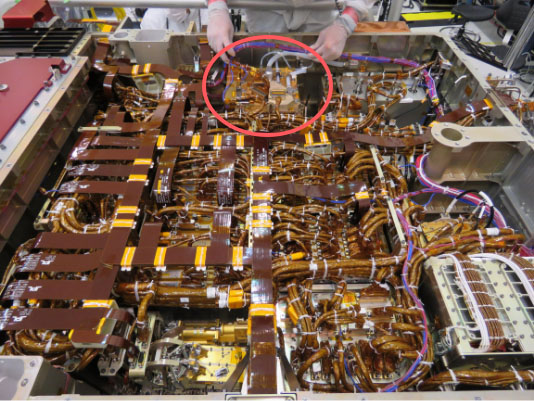 Image credit: NASA/JPL-Caltech | Full image and caption
Image credit: NASA/JPL-Caltech | Full image and caption
Principal Investigator:
Michael Hecht, Massachusetts Institute of Technology
MOXIE is a technology demonstration that will show whether such technology could be used to help launch rockets off the surface of Mars in the future. (The “I” in MOXIE stands for “in situ resource utilization,” or ISRU — the concept of using resources found where a spacecraft lands rather than bringing those resources from Earth.) MOXIE converts carbon dioxide in the Martian atmosphere into oxygen, which is required in massive quantities in order to launch rockets. Larger versions of MOXIE could be brought to Mars in the future to enable astronauts to launch themselves back to Earth. (Launching humans off of Mars will take tens of metric tons of liquid oxygen, which is much more than MOXIE can produce.) Oxygen from MOXIE technology could also be used for breathing, though future systems will need to be about 200 times larger for human missions.
MOXIE
- Is about the size of a car battery and weighs about 38 pounds (17 kilograms).
- Is designed to produce 0.022 pounds of oxygen per hour (10 grams of oxygen per hour).
PIXL (Planetary Instrument for X-ray Lithochemistry)
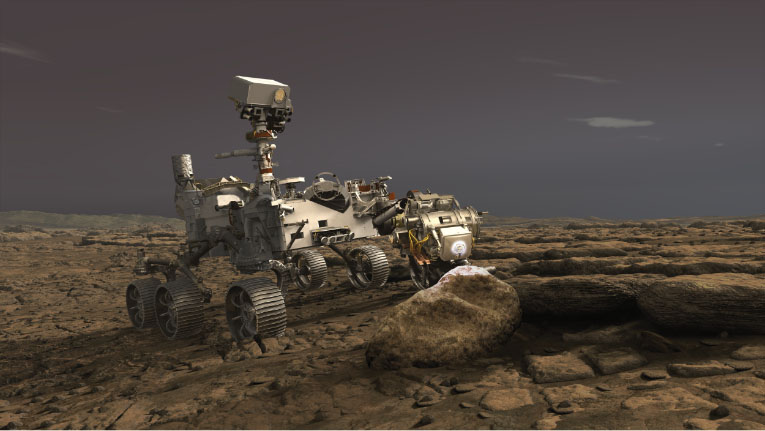 Image credit: NASA/JPL-Caltech | Full image and caption
Image credit: NASA/JPL-Caltech | Full image and caption
Principal Investigator:
Abigail Allwood, JPL
Located on the end of Perseverance’s robotic arm, PIXL aims a tiny but powerful X-ray beam at rocks. This produces a different “glow,” or fluorescence, depending on the rock’s elemental chemistry. PIXL creates postage stamp-sized maps, revealing how and where these chemicals are positioned relative to each other as well as to a rock’s textures and structures. That information can help scientists determine how these features formed, including whether they were biological in nature.
PIXL
- Can detect over 20 chemical elements.
- Takes just 10 seconds to perform a highly accurate analysis of a single point as small as a grain of sand.
- Uses a hexapod (six motorized legs) to scan the instrument and ensure accurate positioning.
RIMFAX (Radar Imager for Mars’ Subsurface Experiment)
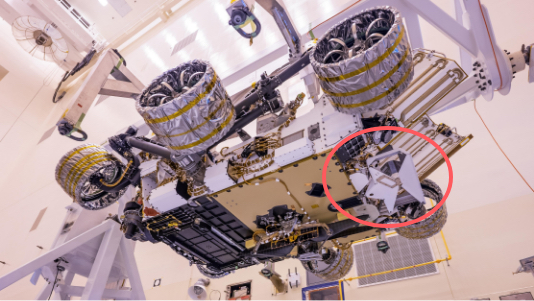 Image credit: NASA/JPL-Caltech | Full image and caption
Image credit: NASA/JPL-Caltech | Full image and caption
Principal Investigator:
Svein-Erik Hamran, University of Oslo
RIMFAX is the first ground-penetrating radar to be carried by a rover or lander to Mars. Such radars have been used by orbiting spacecraft, but bringing them to the surface offers much higher-resolution data. RIMFAX determines how different layers of the Martian surface formed over time.
The Norwegian Defense Research Establishment (FFI) in Kjeller, Norway, provided the instrument.
RIMFAX
- Is based on the design of ground-penetrating radars used to study rock and ice at Earth’s poles.
- Takes its name from “Hrímfaxi,” the horse in Norse mythology that faithfully brings the night.
- Helps pave way for future generations of RIMFAX that could detect water ice deposits for use by astronauts. (Jezero Crater is too warm to harbor subsurface water ice.)
SHERLOC (Scanning Habitable Environments with Raman & Luminescence for Organics & Chemicals)
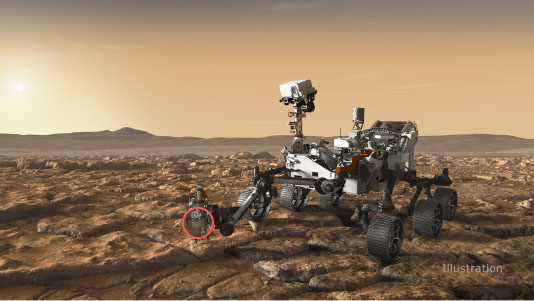 The SHERLOC instrument is circled in red in this illustration of the Perseverance rover. Image credit: NASA/JPL-Caltech | Full image and caption
The SHERLOC instrument is circled in red in this illustration of the Perseverance rover. Image credit: NASA/JPL-Caltech | Full image and caption
Principal Investigator:
Luther Beegle, JPL
SHERLOC is located near PIXL on Perseverance’s robotic arm. As PIXL looks for elemental chemistry, SHERLOC looks for organic molecules and minerals. While the presence of organic molecules helps scientists determine which samples to collect for future return to Earth, the presence of different minerals helps explain how a sample was formed. SHERLOC flashes an ultraviolet laser over surface material, which emits a subtly different glow depending on which organics and minerals are present. SHERLOC also has a camera for taking microscopic images of rock grains and surface textures.
SHERLOC
- Features a camera called WATSON (Wide Angle Topographic Sensor for Operations and eNgineering).
- Has a calibration target that includes five spacesuit materials and a sample of a Martian meteorite.
SuperCam
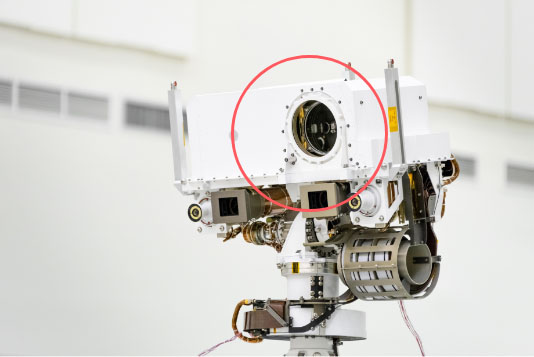 SuperCam’s laser looks like an eye on Perseverance’s mast. Image credit: NASA/JPL-Caltech | Full image and caption
SuperCam’s laser looks like an eye on Perseverance’s mast. Image credit: NASA/JPL-Caltech | Full image and caption
Principal Investigator:
Roger Wiens, Los Alamos National Laboratory, New Mexico
This next-generation version of Curiosity’s ChemCam instrument is located on Perseverance’s mast. Like its predecessor, SuperCam uses a pulsed laser to study the chemistry of rocks and soil. It also uses three new techniques to probe the mineral content of its targets and the hardness of the rocks. One of these techniques heats small amounts of the target to around 18,000 degrees Fahrenheit (10,000 degrees Celsius), creating a bright “spark.” SuperCam can then determine the chemical makeup of these rocks from the plasma that is generated by the laser zaps. More information about its techniques is available in this feature story about the instrument.
SuperCam is a collaboration between Los Alamos National Laboratory and France’s Institut de Recherche en Astrophysique et Planétologie (IRAP), which provided key parts of the instrument, including a special microphone. Spain built and tested the SuperCam calibration target assembly. The Spanish contributions were supported by the Spanish Ministry of Science and Innovation (MICINN), and by the University of Valladolid and local and regional governments.
SuperCam
- Has a laser that can analyze material from up to 20 feet (7 meters) away.
- Records the sound of laser zaps up to 12 feet (4 meters) away with a microphone. The sound changes subtly based on different rock material.
- Can use artificial intelligence to identify and zap rock targets (in addition to the targets chosen by scientists) as the rover awaits new instructions from Earth.
Mars 2020 Science Team Leadership
Project Scientist:
Ken Farley, Caltech, Pasadena, California
Deputy Project Scientists:
Katie Stack Morgan, JPL
Ken Williford, JPL
For a full list of science team members associated with Perseverance’s instruments, visit: https://mars.nasa.gov/mars2020/mission/team/



